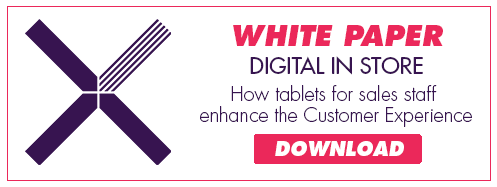
Fashion and luxury goods giants get in on second-hand goods
One of the big current trends in the US is the growth of the second-hand goods market, both online and in-store. The resale of top-of-the-range fashion and luxury goods is really booming in this market. Most brands didn’t see this trend coming, and sites such as ThredUp, TheRealReal, Poshmark and many others attract these brands’ consumers.
2018 second-hand goods market figures

Via https://www.thredup.com/resale
ThredUp is a leading figure on the second-hand goods market. Its market research shows that resale of top-of-the-range and luxury items will continue to grow over the coming decade. Over the next five years, the market should double. Last year, 44 million women bought used fashion items, i.e. 9 million more than in 2016. In 2017-2018, the main resellers grew by 49%, compared to 7% for luxury goods retailers.
What accounts for this used luxury item trend?
Social media and online advertising have extended the range of local stores where customers can hunt for bargains. Smartphones and online sales applications now allow all consumers to buy or sell second-hand items. There has been a switch from a “used goods store” trading area to an “unlimited-destination” trading area. On top of this, second-hand is back with a bang as mentalities change. Previously, used goods were linked to poverty. The term “old” has now been replaced with “vintage” showing the value of authenticity; for many people, there’s no more stigma attached to it. Used clothes also offer the advantage of a reduced carbon footprint, which is especially important for Millennials. 27% of second-hand goods buyers choose this option for environmental reasons but this figure leaps to 35% for Millennials according to the ThredUp survey. There’s nothing new about buying second-hand clothes, but the sector is exploding due to digital technology. In 2017, the second-hand goods market generated $360 billion in the US. By 2022, the market should generate around $400 billion, followed by fashion (clothing, shoes and accessories).
Fashion and luxury goods giants get in on second-hand goods
The US luxury goods market should reach $305 billion by 2020, i.e. 25% less than the used goods market. Luxury firms are therefore banking on the used goods market. For example, LVMH acquired a minority shareholding in Stadium Goods. This new and second-hand streetwear and sneaker brand grew fast over the last two years. Since then, Stadium Goods was bought by FarFetch, a British e-commerce platform featuring more than 1,000 independent online stores, i.e. more than 2,900 luxury and top-of-the-range brands. The Stella McCartney brand joined forces with The RealReal (concept described below) for the “The Future of Fashion is Circular” ". Broadcast on both radio and television and shared on social media, their ad encourages the fashion industry to adopt the “make well, buy well, resell” model. This is the first time that a luxury goods manufacturer actively advocates reselling items.
Second-hand specialists spotted by SQLI Lab
TheRealReal
The RealReal is a start-up launched in 2011 that is beginning to build up its brick-and-mortar presence. It has a permanent store in New York’s SoHo district, and will soon open a second one in Los Angeles. The stores works on a consignment model: sellers drop off items there and The RealReal then commercialises them on its site. Profits are shared with sellers (generally between 50 and 60% go to sellers). The company employs an in-house authentication team, which examines every item to protect against counterfeiting before adding them online.

On-site gemmologists and authentication specialists are available for free jewellery and handbag valuations. Some items can be repaired in-store and sellers can use an on-site collection service, where they can drop off items they want to get rid of. This multi-brand luxury goods store offers a different experience. The RealReal’s expansion comes as other types of retailers, such as department stores, struggle to offer buyers something unique. The RealReal proposes top-of-the-range and luxury branded items, as well as the bargain-hunting experience buyers so enjoy.

ReBag
Rebag is a platform intended exclusively for reselling and buying designer handbags. The platform offers a user-centred selling experience and focuses on immediacy and transparency. Rebag buys bags from individuals who want to get rid of designer items at market prices (calculated by a dedicated team). The process per se is designed to be as simple and easy as possible: no consignment and no commission on resale. All the seller has to do is upload a few images of the bags to get a free estimate and be paid within 2-3 days of valuation and approval of the items by Rebag. Buyers feel safe as they know they’re getting authentic items at attractive prices.

Buyers are open to this concept. Using resources and data available online, they know what e-commerce sites or stores to visit to buy luxury products. The brand is continuing to innovate. It launched Rebag Infinity, a new concept allowing customers to regularly freshen up their bag collection. The customer buys a bag, keeps it for six months, then exchanges it for credit worth at least 70% of the original purchase price. They can also use this amount to buy a new bag.
A fine future for the used goods market
For a long time, luxury brands saw sites like Rebag and The RealReal as enemies. This is no longer the case, in part because these sites generate significant and constantly-growing sales. Kering works actively with The RealReal as its store is a way for the group’s brands to sell unsold goods (which are often destroyed). Many sellers who use The RealReal buy an item from the same brand as the item(s) they sold. It’s not just about getting a good deal but also being a responsible consumer. For Millennials, environmental and social aspects count: it’s a way to reduce the negative externalities generated by the fashion and luxury goods industry.
